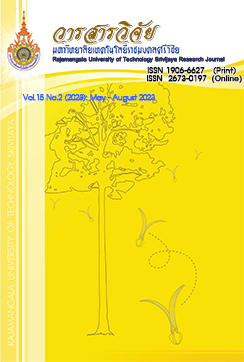Suitable Index for Wetland Monitoring Using Remote Sensing Data
Keywords:
wetland index, remote sensing, LANDSAT 8, Sam Roi YodAbstract
Lack of labor, budget and technology for short time monitoring of wetland conditions has become a major obstacle to sustainable management and conservation of wetlands. A study of the most suitable index for wetland monitoring is using free and easily accessible satellite images from LANDSAT 8 to overcome the mentioned limitations. Five wetland related indices, namely Normalized Difference Water Index (NDWI), Modification of Normalized Difference Water Index (MNDWI), Tasseled-cap Wetness Index (TCWI), Normalized Suspended Material Index (NSMI) and Normalized Difference Suspended Sediment Index (NDSSI) were assessed to classify 6 land covers: high density aquatic-plant, low density aquatic-plant, clear water, low turbidity water, high turbidity water, and forest area in wetland and vicinity areas of Khao Sam Roi Yod National Park in Prajuab Kirikhan Province. For validation of the results, the study area has been divided into 3 zones: water or Zone A, aquatic-plant or Zone B, and forest (including terrestrial plants and others) or Zone C, simple corresponding between land covers in the classified results and the study area were then visually observed. Additional process of accuracy assessment (confusion matrix) using the data from Google Earth database and field survey has been conducted, the derived overall accuracy and kappa coefficient of each result refer to its accuracy. The results showed that only the classification of NDWI presented high correspondence to zonal comparison and calculated accuracy (73.8% of overall accuracy and 0.68 of kappa coefficient). Whereas MNDWI, TCWI, NSMI, and NDSSI showed high confusion in the zones of forest (Zone C) and aquatic-plants (Zone B), and failed to the standard of accuracy with less than 70% of overall accuracy and less than 0.5 of kappa coefficient. In conclusion, NDWI from LANDSAT 8 is a good option and low budgetary for multi-temporal or continuous monitoring in the study area and other wetlands.
References
Arisanty, D. and Saputra, A.N. 2017. Remote Sensing Studies of Suspended Sediment Concentration Variation in Barito Delta, pp. 1-7.
In IOP Conference Series: Earth and Environmental Science, Volume 98, The 5th Geoinformation Science Symposium 2017 (GSS 2017). Yogyakarta, Indonesia.
Baig, M.H.A., Zhang, L., Shuai, T. and Tong, Q. 2014. Derivation of a tasselled cap transformation based on Landsat 8 at-satellite reflectance. Remote Sensing Letters 5(5): 423-431.
Blackmore, D.S. 2016. Use of Water Indices Derived from Landsat OLI Imagery and GIS to Estimate the Hydrologic Connectivity of Wetlands in the Tualatin River National Wildlife Refuge. Master Thesis of Science (Geography), Portland State University.
Department of Mineral Resources. 2008. Zoning Classification for Geology and Mineral Resources Management of Prachuap Khiri Khan Province. Advance Vision Service Limited, Bangkok. (in Thai)
Hossain, A.K.M.A., Jia, Y. and Chao, X. 2010. Development of Remote Sensing Based Index for Estimating/Mapping Suspended Sediment Concentration in River and Lake Environments, pp. 578-585. In ISE Proceeding, The 8th international symposium on ECOHYDRAULICS (ISE 2010). International Association for Hydraulic Engineering and Research (IAHR), South Korea.
Lv, J., Jiang, W., Wang, W., Wu, Z., Liu, Y., Wang, X. and Li, Z. 2019. Wetland Loss Identification and Evaluation Based on Landscape and Remote Sensing Indices in Xiong’an New Area. Remote Sensing 11(23): 2834.
L3Harris Geospatial Solutions, Inc. 2022. Fast Line-of-sight Atmospheric Analysis of Hypercubes (FLAASH). Available Source: https://www.l3harrisgeospatial.com/docs/flaash.html, May 20, 2022.
McFeeters, S.K. 1996. The use of Normalized Difference Water Index (NDWI) in the delineation of open water features. International Journal of Remote Sensing 17(7): 1425-1432.
Montalvo, L.G. 2010. Spectral Analysis of Suspended Material in Coastal Waters: A Comparison Between Band Math Equations. Available Source: https://docplayer.net/39330139-Spectral-analysis-of-suspended-material-in-coastal-waters-a-comparisonbetween-band-math-equations.html, January 13, 2021.
Mozumder, C., Tripathi, N.K. and Tipdecho, T. 2014. Ecosystem evaluation (1989–2012) of Ramsar wetland Deepor Beel using satellite-derived indices. Environmental Monitoring and Assessment 186(2014): 7909-7927.
National Parks of Thailand. 2021. Khao Sam Roi Yot National Park – General Information. Available Source: https://nps.dnp.go.th/parksdetail.php?id=129&name=KhaoSamRoiYotNationalPark, February 20, 2021. (in Thai)
Ngwenya, K. and Marambanyika, T. 2021. Trends in use of remotely sensed data in wetlands assessment and monitoring in Zimbabwe. African Journal of Ecology 59(3): 676-686. doi: 10.1111/aje.12858.
Rapinel, S., Fabre, E., Dufour, S., Arvor, D., Mony, C. and Hubert-Moy, L. 2019. Mapping potential, existing and efficient wetlands using free remote sensing data. Journal of Environmental Management 247(2019): 829-839.
Sarun, S., Vineetha, P. and Kumar, R.A. 2016. Semi-Automated Methods for Wetland Mapping Using Landsat ETM+: A Case Study from Tsunami Affected Panchyats of Alappad & Arattupuzha, South Kerala. International Journal of Science and Research 5(8): 1150
-1154.
Shahzad, M.I., Meraj, M., Nazeer, M., Zia, I., Inam, A., Mehmood, K. and Zafar, H. 2018. Empirical estimation of suspended solids concentration in the Indus Delta Region using Landsat-7 ETM+ imagery. Journal of Environmental Management 209: 254-261.
Sun, J., Cao, J., Duan, H., Yan, C. and Wang, T. 2012. Monitoring ecological health of wetlands and adjacent uplands by combining MODIS vegetation index and wetness index, pp. 1-4. In Proceeding, International Symposium on Geomatics for Integrated Water Resource Management. Geomatics for Integrated Water Resources Management (GIWRM), China.
Tang, Z., Li, Y., Gu, Y., Jiang, W., Xue, Y., Hu, Q., LaGrange, T., Bishop, A., Drahota, J. and Li, R. 2016. Assessing Nebraska playa wetland inundation status during 1985-2015 using Landsat data and Google Earth Engine. Environmental Monitoring and Assessment 188(12): 654.
Thai Meteorological Department. 2021. Report of Natural Disasters in Thailand. Available Source: http://climate.tmd.go.th/disaster/, February 20, 2021.
Xu, H. 2006. Modification of Normalized Difference Water Index (NDWI) to Enhance Open Water Features in Remotely Sensed Imagery. International Journal of Remote Sensing 27(14): 3025-3033.
Downloads
Published
How to Cite
Issue
Section
License
Copyright (c) 2023 Rajamangala University of Technology Srivijaya Research Journal

This work is licensed under a Creative Commons Attribution-NonCommercial-NoDerivatives 4.0 International License.
The content and information in the article published in Journal of Rajamangala University of Technology Srivijaya It is the opinion and responsibility of the author of the article. The editorial journals do not need to agree. Or share any responsibility.







